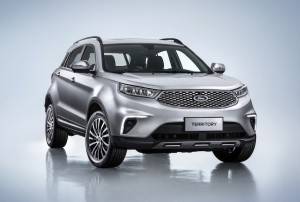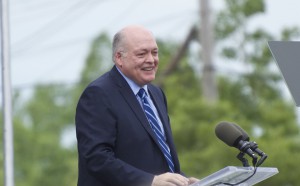
Ford's new entry-level sport-utility, the Territory, is the first of a wave of 50 new or redesigned products for China.
Despite being the world’s largest car market, China turned out to be a big money-loser for Ford Motor Co. during the third quarter, contributing $378 million in red ink and dragging down the automaker’s overall earnings for the quarter.
The Chinese market has been struggling, of late, suffering a rare slump in sales, but Ford has been especially hard hit, reflecting the company’s late entry into the market and a series of product planning errors. So, the massive Asian market is at the heart of CEO Jim Hackett plans for a broader corporate turnaround.
“Success in China is critical as we reposition our global business for long-term success,” said Hackett, as he announced key changes for Ford’s Chinese operations. “With today’s actions, we are strengthening our commitment to the China market and reorganizing our international markets to strengthen their performance.”
(Click Here to check out Ford’s new midsize Chinese SUV, the Territory.)
Following the lead of key competitors like General Motors, Ford is shaking up its Chinese operations, turning them into a stand-alone operation. It has also replaced Jason Luo, its former China chief, with Chen Anning, a veteran in the market recruited from local Chinese powerhouse Chery Automobile.
Chen won’t have to learn the ropes at Ford entirely. Educated in the U.S., he spent the first 17 years of his 25-year career working for the Blue Oval.
Ford was a relative latecomer to China, lagging years behind key rivals General Motors and Volkswagen AG before planting its flag there. Under former CEOs Alan Mulally and Mark Fields, it was stuck playing a costly game of catch-up, but continued to struggle to find the sweet spot as the Chinese market not only grew to become the world’s largest but shifted in terms of consumer tastes.
Complicating matters, after nearly two decades of double-digit growth, Chinese new vehicle sales slipped by 11.6% in September. It was the worst dip in nearly seven years and followed a 3.8% tumble fall in August, Sales were off 4.0% in July. The last monthly sales increase came in June, a modest – by Chinese standards 4.8 percent. The market hasn’t experienced anywhere near as steep a decline since September 2012 when demand dropped 26.4%, and that was partially blamed on the timing of Chinese New Year, a period when commerce, in general, tumbles.
(China car market tumbles, creating problems for American automakers. Click Here for the story.)
Ford itself has tumbled even faster than the overall Chinese market, the Detroit maker dipping 43% year-over-year in September, after tumbling in July and August, as well. That followed an overall year-over-year decline of 6% in 2017.
Luo’s resignation was widely expected considering Ford’s poor performance in China, but some observers stressed that the former China chief was dealt a poor hand, among other things, by having a relatively weak product portfolio to work with.
Chen will have at least one critical new model line to help him begin the rebuilding process, a new China-only midsize SUV dubbed Territory, developed in partnership with one of its its Chinese joint-venture partners, Jiangling Motors Corp.
Ford plans to add or update 50 products in the next few years for the massive market, including core models like the Focus and Escort.
It also plans to increase local production for both the Ford brand and Lincoln, the latter brand still ramping up its presence in the country. Some of that shift in production will likely compensate for the impact that the Trump Administration’s tit-for-tat trade war has had, limiting exports of American-made vehicles to China because of the Beijing government’s increase in tariffs from 25% to 40 percent.
Among other moves, Ford plans to create a new line of battery-electric vehicles as part of a new joint venture with Chinese automaker Zotye.
Along with new model earmarked for the U.S. and other markets, the product push in China shows Ford is “building momentum shifting our product portfolio to build on our strengths and meet shifting consumer demand,” Hackett said during an earnings call on Wednesday.
(To find out why Ford has scrubbed plans to sell the Chinese-made Focus crossover in the U.S., Click Here.)


